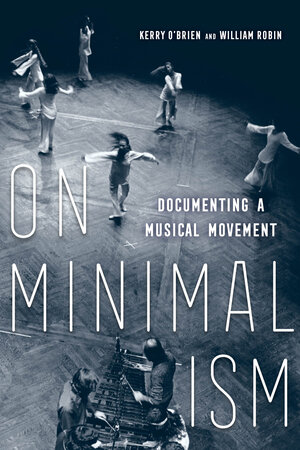By Kerry O’Brien and William Robin, co-authors of On Minimalism: Documenting a Musical Movement
“Thursday evening was a major moment for musical Minimalism,” the New York Times declared last month. The Chicago Symphony had played a new Philip Glass work at Carnegie Hall while, nine blocks uptown, the New York Philharmonic premiered a piece by Steve Reich at Lincoln Center. “They were once downtown rebels, writing for their own ensembles rather than major symphonic forces,” chief critic Zachary Woolfe noted of the two octogenarian composers. “Imagine predicting, back then, that they would have new work presented on the same night by two of the country’s great orchestras, in the two temples of New York’s musical establishment.”

Minimalism, triumphant: it’s a familiar story. Jump back a few decades to 1986 and you could read, in the same paper, of the fifty-year-old Reich’s triumph when his ensemble played Lincoln Center for the first time; or, a few years earlier, when the New York Philharmonic first performed his music. Glass’s uptown triumphs began when his Einstein on the Beach made it to the Metropolitan Opera in 1976, although his Philharmonic arrival took until 2017.
The history of minimalist music is often told through such moments of downtown rebels becoming uptown eminences. Glass and Reich are the main heroes, the exemplars of this narrative, though musicians, critics, and scholars will typically begin the story with La Monte Young and Terry Riley, mavericks who didn’t move into the establishment but helped forge the musical style that did. As typically told, it’s a story of the ’60s counterculture creating a musical vision that found broad appeal and eventually mainstream recognition, while managing to retain its air of rebellion.
It’s also a story that we tell in our new book, On Minimalism: Documenting a Musical Movement, by reprinting dozens of primary sources, from liner notes and interviews to newspaper articles and obscure manifestos. Retelling this classic story of minimalism is crucial to our narrative: we document Reich’s Music for 18 Musicians and Glass’s Einstein, the twin 1976 masterworks that brought the movement major recognition, and the canonization that ensued.
But it’s not the only story we tell. For too long, the story of minimalism has been narrowed into this single triumphant lineage: the developments of Young, Riley, Glass, and Reich, the so-called “Big Four.” 1976 also brought us Catherine Christer Hennix’s uncanny “Electric Harpsichord”—less a “masterwork” in the conventional sense than what the composer Henry Flynt once described as a new form of science, a hallucinatory environment of sound. Hennix herself represents an oft-overlooked lineage within minimalism: the powerful influence of Pandit Pran Nath, the Indian guru whom Young installed in his loft to teach a generation of experimental disciplines, including Hennix, Flynt, Jon Hassell, and Yoshi Wada.
There are other uncanny, forgotten stories of minimalism. Some are deeply spiritual: the musician-guru Laraaji created spellbinding repetitions with an electrified autoharp, seeking “a state of oneness with the Divine Presence”; composer Annea Lockwood gathered with a group of women to drone on a single pitch, convinced of sound’s healing properties (and curious whether sound could actually move objects).
And there are other origin stories, too: in the early ’60s, just as the “Big Four” was finding their sound, John Coltrane, in the wake of powerful encounters with the music of Ravi Shankar, began improvising his sheets of sound atop static drones. There was Yoko Ono, whose loft served as home for experimental happenings by Young, John Cage, and Ono herself. There was the first-ever marathon of Erik Satie’s “Vexations,” a cosmic joke shepherded by John Cage in which a two-minute piano piece was repeated 840 times, with contributors that included the Velvet Underground’s John Cale and the Bach scholar Joshua Rifkin.
And there are many, many stories of skepticism: dislike of minimalism’s noisy amplification, distrust of its repetition, fear of its canonization. There was the eminent academic composer Leon Kirchner describing Glass’s music as “lobotomized Bruckner,” and his colleague Charles Wuorinen calling it “an aspect of a society-wide mental illness.” There was music critic Ian MacDonald, excoriating the music’s widespread listenership in the late 1980s:
“Something happens to people who listen to too much Minimalism. They begin to smile fatuously, display a genially indiscriminate omni-tolerance (known to contemporary psychiatry as ‘the Castella mood’), and put their feet up on your furniture. Some start wearing dungarees and playing with frisbees. At night, the Minimalee’s mind is gridlocked with blink-blinks and fiddle-iddles, his sleep shallow with the hi-fi equivalent of the ‘bleeping sickness’ suffered by compulsive enthusiasts of Space Invaders. Soon it becomes inescapably obvious to even the dullest observer: Minimalees are overgrown kids.”
And, importantly, there was backlash from within: those musicians who, witnessing the triumph of Reich and Glass seemingly at the expense of the all-encompassing experimental vision of the ‘60s, dissented. “Those who took credit for it, they did it, now they’re on the cover of every magazine, they’re these creatures of the media,” the gonzo composer-organist Charlemagne Palestine said in a 1989 interview. “Was all of it just about making sonoric aspirin so people could just feel better, or is anybody out there just listening or caring?”On Minimalism attempts to hold all these narratives together: the stories of triumphs and setbacks, of fringe figures who became mainstream and those who chose, resolutely, to remain at the margins. It is our hope that, in placing all those stories together, we reveal a bigger, unrulier, and more comprehensive musical minimalism, one that can help us better see all of the movement’s offshoots today: not just Glass and Reich in big concert halls, but also Sunn)))’s sludgy feedback, Eva-Maria Houben’s hushed lullabies, Nala Sinephro’s ambient jazz, Sarah Hennies’s psychoacoustic resonances, and much more.

